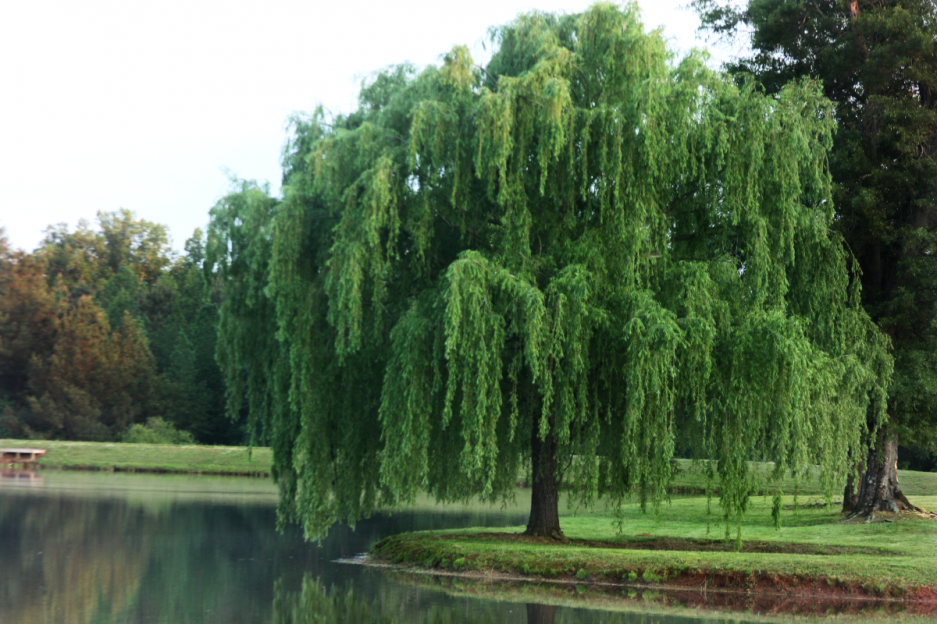(credit to blog.gwcollegedemocrats.com)
Emma Swaninger
Dr. Kim Thompson
PBIO: Plants and People
March 11, 2015
Willow Trees (Salix) and Erosion Control
There are few trees more capable of preventing erosion in an affected area than the willow tree. In the early days of settlers, they would often cut down this seemingly “useless” tree to form fences around their homes. However, out of nowhere, pioneers were baffled to see that soon after, the areas where the wood was hammered in the ground, strange sprouts began to propagate out of the soils (Margolin, 1986). As the tree grew outward, its vast roots expanded and laced itself skillfully and quickly into the soils. Generally, wood would start to experience decay after a couple of months of exposure to the outside world, but these willow posts planted in the ground, took a very different affect (Margolin, 1986).
Today, many of the Salix species of trees are recommended as some of the top trees to prevent erosion in quasi-stable areas. The Department of Ecology in the state of Washington produced a list of different plants that would be beneficial to stabilize slopes and areas that need immovability; right after the Red Alder tree, there are three different willow trees, as well as a flurry of other willow species throughout the rest of the list (Department of Ecology, 1994-2014). Not only do willows have large root systems, but they also grow fairly quickly. They have the ability to get into the small spaces of rocks and soil and keep them in place (Margolin, 1986). As if that was not enough, these magnificent trees have massive canvases that can canopy over an area and soak up rain water. By doing this, it further prevents water from reaching the ground (Edgar, 2013).
Knowledge of this is important in many aspects of natural life, such as regulation of streams, river beds and water banks. As a geological sciences student, one can appreciate the affect that these tremendous roots would have in fluvial geomorphology and impacting the control of environmental changes. There have been several success stories experienced by the U.S. Army Corps of Engineers in the past pertaining to the uses of willow trees along river banks (Derrick, 2014). One stream, for example, was experiencing incision which was causing the stream to over-widen and alter its floodplain and general path into different directions than previously understood (Derrick, 2014). To prevent this, the U.S. Army Corps of Engineers not only re-meandered the channel but they planted much vegetation, including willow trees, around the banks as to slow down the headcut’s effect on the stream (Derrick, 2014).
Economically, the willow tree is also very beneficial. In addition to being able to reduce erosion on stream and river banks, they are easy to control and maintain (Illinois State Water Survey, 1991). Typical erosion techniques with cement and steel may cost somewhere in the triple digits per foot, but if willow posts were replacing these methods, this would cut costs to being around fifteen dollars per foot (Illinois State Water Survey, 1991). Furthermore, not only are state departments saving money and resources on flood and erosion control by using willow trees and other willow species, but other valuable and plush plant life then has the ability to grow substantially in the areas that are being regulated by these willows (Illinois State Water Survey, 1991).
Citation
Edgar, Tricia. “Willow Roots: Ecological Answer to Erosion – Just Choose Native Trees.” Decoded Science. 24 Jan. 2013. Web. 12 Mar. 2015. <http://www.decodedscience.com/willow-root-erosion-ecology/24395>.
Margolin, Malcom. “Propagating Willow Trees for Soil Erosion Control.” Mother Earth News. Ogden Publications, Inc., 1 Apr. 1986. Web. 12 Mar. 2015. <http://www.motherearthnews.com/nature-and-environment/trees-for-soil-erosion-zmaz86mazgoe.aspx>.
Illinois State Water Survey. “The Willow-Post Method for Streambank Stabilization.” Streambank Erosion. Illinois State Water Survey, 1 Sept. 1991. Web. 12 Mar. 2015. <http://www.isws.illinois.edu/pubdoc/mp/iswsmp-130.pdf>.
“Plant Selection Guide.” Slope Stabilization. Washington State Department of Ecology. Web. 12 Mar. 2015. <http://www.ecy.wa.gov/programs/sea/pubs/93-30/table3.html>.
Derrick, David.”Stream, River Bed, and Bank Erosion Control Training Engineer Research and Development Center Fact Sheet Article View.” Stream, River Bed, and Bank Erosion Control Training Engineer Research and Development Center Fact Sheet Article View. U.S. Army Corps of Engineers, 1 Jan. 2014. Web. 12 Mar. 2015. <http://www.erdc.usace.army.mil/Media/FactSheets/FactSheetArticleView/tabid/9254/Article/476713/stream-river-bed-and-bank-erosion-control-training.aspx>.


Awesome blog post! Crazy to think people used to see these trees as useless! Loved learning how nature itself can be used to impact environmental changes! Great insight and explanation!!!!
LikeLike
Thank you for the read! I’m glad you enjoyed it! Did you know that a willow tree can grow about 1-1.5 ft per year? So you can see how that would be a huge impact for the environment and controlling it.
LikeLike